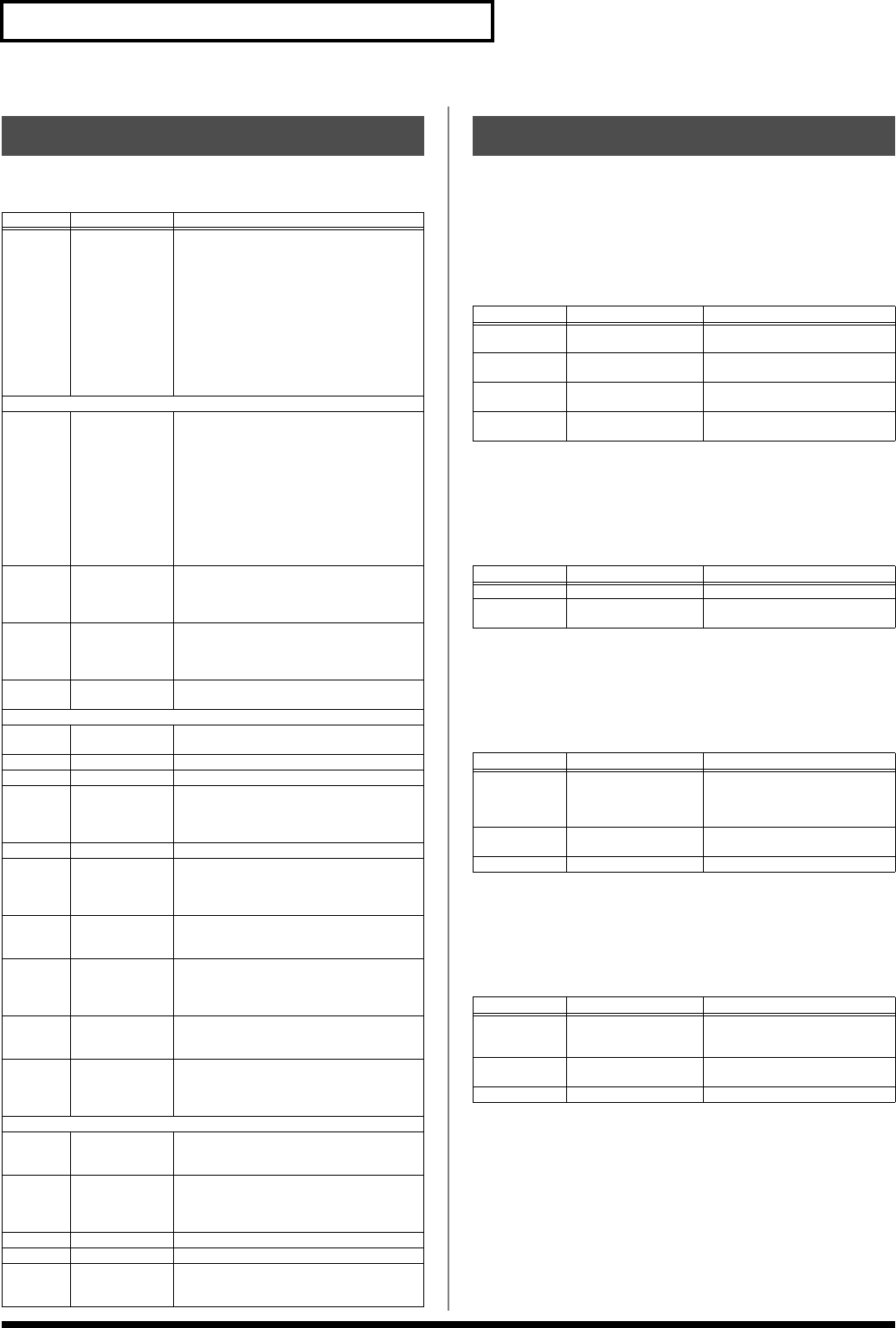
294
Effects List
These settings allow you to select the desired type of reverb, and its
characteristics.
Selects the type of effect that will be applied to the external input
source.
01: EQUALIZER
Adjusts the tone of the low-frequency and high-frequency ranges.
02: ENHANCER
Modifies the harmonic content of the high-frequency range to add
sparkle to the sound.
03: COMPRESSOR
Restrains high levels and boosts low levels to make the overall
volume more consistent.
04: LIMITER
Compresses the sound when it exceeds a specified volume, to keep
distortion from occurring.
Reverb Parameters
Parameter
Value Description
Reverb
Type
0 (OFF),
1 (REVERB),
2 (SRV ROOM),
3 (SRV HALL),
4 (SRV PLATE),
5 (GM2 REVERB)
Type of reverb
0 (OFF): Reverb is not used.
1 (REVERB): Normal reverb
2 (SRV ROOM): This simulates typical
room acoustic reflections.
3 (SRV HALL): This simulates typical con-
cert hall acoustic reflections.
4 (SRV PLATE): This simulates a reverb
plate, a popular type of artificial reverb
unit that derives its sound from the vibra-
tion of a metallic plate.
5 (GM2 REVERB): GM2 Reverb
Type: 1 (REVERB)
Type
ROOM1,
ROOM2,
STAGE1,
STAGE2,
HALL1, HALL2,
DELAY,
PAN-DELAY
Type of reverb/delay
ROOM1: short reverb with high density
ROOM2: short reverb with low density
STAGE1: reverb with greater late rever-
beration
STAGE2: reverb with strong early reflections
HALL1: very clear-sounding reverb
HALL2: rich reverb
DELAY: conventional delay effect
PAN-DELAY: delay effect with echoes
that pan left and right
Time 0–127 Time length of reverberation
(Type: ROOM1–HALL2)
Delay time
(Type: DELAY, PAN-DELAY)
HF Damp 200–8000 Hz,
BYPASS
Adjusts the frequency above which the high-
frequency content of the reverb sound will be
cut, or “damped.” If you do not want to cut the
high frequencies, set this parameter to BYPASS.
Delay
Feedback
0–127 Adjusts the amount of delay feedback when
the Type setting is DELAY or PAN-DELAY.
Type: 2 (SRV ROOM)/3 (SRV HALL)/4 (SRV PLATE)
Pre
Delay
0.0–100.0 ms
Adjusts the delay time from the direct sound
until the reverb sound is heard.
Time 0–127 Time length of reverberation
Size 1–8 Size of the simulated room or hall
High Cut 160 Hz–12.5 kHz,
BYPASS
Adjusts the frequency above which the high-
frequency content of the reverb will be re-
duced. If you do not want to reduce the high
frequencies, set this parameter to BYPASS.
Density 0–127 Density of reverb
Diffusion 0–127
Adjusts the change in the density of the reverb
over time. The higher the value, the more the den-
sity increases with time. (The effect of this setting
is most pronounced with long reverb times.)
LF Damp
Freq
50–4000 Hz Adjusts the frequency below which the low-
frequency content of the reverb sound will be
reduced, or “damped.”
LF Damp
Gain
-36–0 dB Adjusts the amount of damping applied to
the frequency range selected with LF Damp.
With a setting of “0,” there will be no reduc-
tion of the reverb’s low-frequency content.
HF Damp
Freq
4000 Hz–12.5 kHz
Adjusts the frequency above which the high-
frequency content of the reverb sound will be
reduced, or “damped.”
HF Damp
Gain
-36–0 dB Adjusts the amount of damping applied to
the frequency range selected with HF Damp.
With a setting of “0,” there will be no reduc-
tion of the reverb’s high-frequency content.
Type: 5 (GM2 REVERB)
Character
0–7 Type of reverb
0–5: reverb
6, 7: delay
Pre-LPF 0–7 Cuts the high frequency range of the sound
coming into the reverb.
Higher values will cut more of the high
frequencies.
Level 0–127 Output level of reverbration
Time 0–127 Time length of reverberation
Delay
Feedback
0–127 Adjusts the amount of the delay sound that is
fed back into the effect when the Reverb
Character setting is 6 or 7.
Input Effect Parameters
Parameter
Range Explanation
Low Freq
200, 400 Hz Center frequency of the low-fre-
quency range
Low Gain -15–+15 dB Amount of low-frequency
boost/cut
High Freq 2000, 4000, 8000 Hz Center frequency of the high-
frequency range
High Gain -15–+15 dB Amount of high-frequency
boost/cut
Parameter
Range Explanation
Sens
0–127 Depth of the enhancer effect
Mix 0–127 Volume of the harmonics that
are generated
Parameter
Range Explanation
Attack
0–127 Time from when the input ex-
ceeds the Threshold until the
volume begins to be com-
pressed
Threshold 0–127 Volume level at which compres-
sion will begin
Post Gain 0–+18 dB Level of the output sound
Parameter Range Explanation
Release 0–127 Time from when the input falls
below the Threshold until com-
pression ceases
Threshold 0–127 Volume level at which compres-
sion will begin
Post Gain 0–+18 dB Level of the output sound
Fantom-X678_r_e.book 294 ページ 2005年5月12日 木曜日 午後4時40分


















